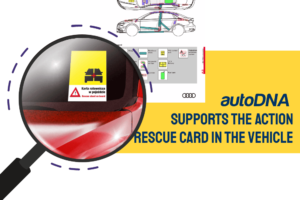
How to sell a used car? autoDNA guide
Table of Contents
Table of Contents
Selling a used motor vehicle can be a rewarding experience if approached correctly. Whether you’re upgrading your vehicle or simply looking to make some extra cash by securing the best price, this guide from autoDNA will help you navigate the process with ease. Let’s review the basic steps to ensure a smooth and successful sale and learn how to sell a used car.
Selling a used car offers a unique opportunity to maximize the value of your current vehicle while ensuring it transitions to a new owner smoothly. Many car owners underestimate the importance of preparation, but a little effort upfront can lead to significant returns. This comprehensive guide will walk you through the entire process of selling a used car, from preparing the vehicle for sale to closing the deal with confidence.
Let’s dive into the details and discover how to turn your used car into a sought-after asset that buyers can’t resist.
1. Prepare your vehicle for sale
Before listing your car, it’s crucial to ensure it’s in the best possible condition. Here’s how:
Clean your car inside and out: A clean car makes a great first impression. Wash nd vacuum thoroughly. Pay special attention to details like cleaning windows, polishing chrome accents, and deodorizing the interior. For a private party sale, a well-maintained car can set your listing apart from others.
Address minor repairs: Fix small issues like burnt-out bulbs, chipped paint, or minor dents. If you’ve been delaying maintenance, now’s the time to take care of it. Consider getting a professional inspection to address any underlying issues, as a buyer in a private party sale may request this step. Replace worn wiper blades and ensure the tires have sufficient tread. Small investments in repairs can significantly increase the perceived value of your vehicle.
Gather documentation: Collect the vehicle’s title, maintenance records, and warranty information. Having these documents ready is especially important for a private party sale, as buyers often look for transparency and detailed records. Include receipts for recent repairs or upgrades to showcase your commitment to the car’s upkeep. If you’ve added aftermarket upgrades like a stereo or custom rims, gather those receipts too. Additionally, prepare a summary of any major repairs or replacements, such as a new timing belt or transmission work.
Check your vehicle history: Use a service like autoDNA to generate a vehicle history report. This builds trust with potential buyers and is particularly useful for private party sales to showcase your car’s reliability. Highlight any positive aspects of the report, such as a clean accident history or regular servicing. If the car was involved in a minor accident but repaired professionally, disclose this upfront to avoid surprises. When selling your car online, showcasing a vehicle history report is even more critical as buyers may not have the chance to inspect the car in person. Providing detailed and transparent information can make your car listing stand out in the crowded online marketplace, increasing the chances of a quick and smooth sale.
2. Determine your car’s value
Knowing your car’s worth helps you set a fair and competitive price. Consider the following:
Research market prices: Check online listings for similar makes and models in your area.
For a private party sale, it’s important to compare prices from individual sellers rather than dealerships, as these often differ significantly.
Take note of mileage, condition, and features when comparing. Include filters for your region to get a more accurate idea of what buyers are willing to pay locally. Consider the growing trend of selling cars online through platforms which offer a simpler solution for sellers.
Use valuation tools: Use autoDNA or other trusted platforms to get an estimate based on mileage, age, and condition. This data is especially helpful for private party sales where buyers often negotiate based on such details. Combine multiple sources to arrive at a realistic asking price. Also, consult local dealerships for trade-in offers to understand the baseline value, but keep in mind that private sales often yield a higher price. Online car buyers provide instant offers and quick transactions, though the selling price may be lower compared to private sales.
Factor in upgrades: Highlight any features or upgrades that add value, such as a new stereo system, recent tire replacement, or added safety features. In a private party sale, showcasing these extras can make your listing stand out. Be sure to adjust your price accordingly, but stay within a competitive range. Consider creating a list of added features with their approximate value to justify your asking price during negotiations.
Consider local demand: Certain car models or features may be more desirable in your area. For example, all-wheel-drive vehicles are often sought after in regions with harsh winters. Adjust your price to reflect local trends and demand. Use local classified ads or social media groups to gauge what similar motor vehicles are selling for. If you live in a city where fuel efficiency is a priority, emphasize this in your pricing strategy and advertising.
Selling a convertible in summer or an SUV in winter can influence your pricing strategy. Adjust your timing if necessary to maximize your profit.
3. Create an eye-catching listing
A compelling listing is essential to attract buyers. A compelling listing is essential to attract prospective buyers and stand out in a crowded market. Follow these tips:
Write a clear title: Include key details like the year, make, and standout features. A clear and concise title immediately captures the attention of a prospective buyer, making them more likely to click on your listing. By tailoring the title to highlight features that appeal to a prospective buyer, you improve your chances of standing out in crowded online marketplaces.
Include high-quality photos: Capture your car from multiple angles, showing both the exterior and interior. Use natural lighting and ensure the car is clean and clutter-free. For a private party sale, professional-looking photos can increase buyer confidence. Include close-ups of unique features like alloy wheels, a pristine dashboard, or upgraded tech components. Show any imperfections honestly, like small scratches, to build trust.
Be honest and detailed: Describe the car’s condition, mileage, and any recent maintenance. Avoid exaggerating or omitting key details, as transparency is crucial in a private party sale. Mention if the car has been smoked in, if pets were transported, or if it’s been primarily used for city or highway driving. Provide detailed specifications like fuel economy, horsepower, and cargo capacity.
Highlight key selling points: Mention low mileage, fuel efficiency, advanced features, or unique upgrades. Buyers in private party sales are often looking for value-added benefits. Use bullet points to make the ad easy to skim. If your car has a high safety rating or advanced driver-assistance systems, emphasize these features.
Provide a call to action: Encourage potential buyers to contact you with questions or schedule a viewing. For example, “Contact me today to schedule a test drive!” Include your availability and preferred contact method. Provide alternative ways to connect, such as email or social media.
4. Advertise your car
Reach a wider audience by using multiple platforms:
Online marketplaces: Include detailed descriptions and high-quality photos to stand out. Don’t forget to check responses regularly to avoid losing potential buyers.
Social media: Share your listing with friends and family. Ask them to share it within their networks to reach more potential buyers.
Local advertising: Use community bulletin boards or local newspapers. For a private party sale, consider attending car meetups or local events where you can showcase your vehicle in person. Print flyers with essential details and a QR code linking to your online ad. When dealing with an out-of-town buyer, ensure to meet in safe, public places and provide clear navigation assistance during test drives.
5. Communicate with potential buyers
Handling inquiries effectively can speed up the sale:
Respond promptly: Answer questions and provide additional photos or information as needed. A quick response demonstrates professionalism and interest in selling. Reply within hours if possible to keep buyers engaged.
Be transparent: Share the vehicle history report to instill confidence. Buyers in private party sales often value honesty and are more likely to proceed with transparent sellers. Discuss any known issues openly.
Schedule test drives safely: Meet in a public place and verify the buyer’s ID and insurance. Accompany them during the test drive, and ensure all questions are answered afterward. Plan test drives during daylight for safety.
Be professional: Treat all inquiries with respect and patience. Even if a buyer seems hesitant, clear communication can help them decide. Keep detailed notes of interested buyers and their contact information.
Consider using a cashier’s check for secure payment, as it guarantees that the funds are immediately withdrawn from the buyer’s account.
6. Negotiate and close the deal
Once you find an interested buyer, it’s time to finalize the sale:
Negotiate fairly: Be prepared to counter offers but stick to your minimum price. A private party sale often involves more negotiation, so remain polite and flexible while standing firm on your bottom line. Use phrases like, “I believe this is a fair price based on market research.”
If you still owe money on the vehicle, ensure clear communication with the buyer and handle the title transfer properly.
Draft a bill of sale: Include details like the purchase price, date, and buyer/seller information. This document protects both parties and formalizes the agreement. Consider using a template from a trusted source.
Transfer ownership: Sign over the title and notify your local DMV or equivalent authority. Some jurisdictions may require additional paperwork, so check local regulations. Verify that the buyer completes their part of the ownership transfer promptly.
Secure payment: Accept cash, a cashier’s check, or use a trusted escrow service. Verify the payment method’s authenticity to avoid scams. If using electronic payment, ensure funds are transferred before handing over the keys.
Provide final documents: Hand over the vehicle history report, owner’s manual, and spare keys. This leaves a good impression and ensures a smooth transition for the buyer. Include any additional accessories like floor mats or roof racks.
Additional tips for a successful sale
Timing matters: Spring and summer are often the best seasons to sell a car, as demand tends to be higher. Plan your sale during these peak periods for quicker results. A private sale can often yield higher profits by avoiding middlemen like dealerships.
Be patient: Finding the right buyer can take time. Avoid rushing into a deal that doesn’t feel right. Keep updating your ad to keep it visible in search results.
Stay safe: Trust your instincts during interactions and test drives. If something feels off, prioritize your safety. Bring a friend or family member if you feel uneasy meeting a buyer alone.
Prepare for questions: Be ready to answer common questions, such as why you’re selling the car, its gas mileage, and whether it has any warranties remaining. Create a FAQ document you can share with potential buyers to streamline the process.
Conclusion
Knowing how to sell your car doesn’t have to be stressful. By preparing your vehicle, setting a competitive price, and marketing it effectively, you can find the right buyer and close the deal with confidence. For added transparency, consider using autoDNA’s vehicle history reports to enhance trust and streamline the process. Good luck with your sale!
autoDNA is the leading provider of services of checking vehicle history online and free VIN lookup. Based on your VIN number, with autoDNA you can verify vehicle history before making a purchase. In many cases, VIN check may prevent you from incurring unwanted additional costs associated with purchasing a vehicle with an unknown or salvage past.
How can I determine the value of my car?
You can use online valuation tools, check similar listings in your area, and consider factors like mileage, condition, and local demand. autoDNA’s valuation services can also provide a reliable estimate. The current market demand for used cars, influenced by factors like chip shortages and inventory levels at dealerships, can also affect your car's value.
Should I repair my car before selling it?
It depends on the condition of your car. Fixing minor issues like scratches, dents, or worn tires can increase your car’s value and attract more buyers. For major repairs, weigh the cost against the potential increase in sale price.
Read also about:

















